Can Mike Amiri Build the Next Global Luxury Fashion House?
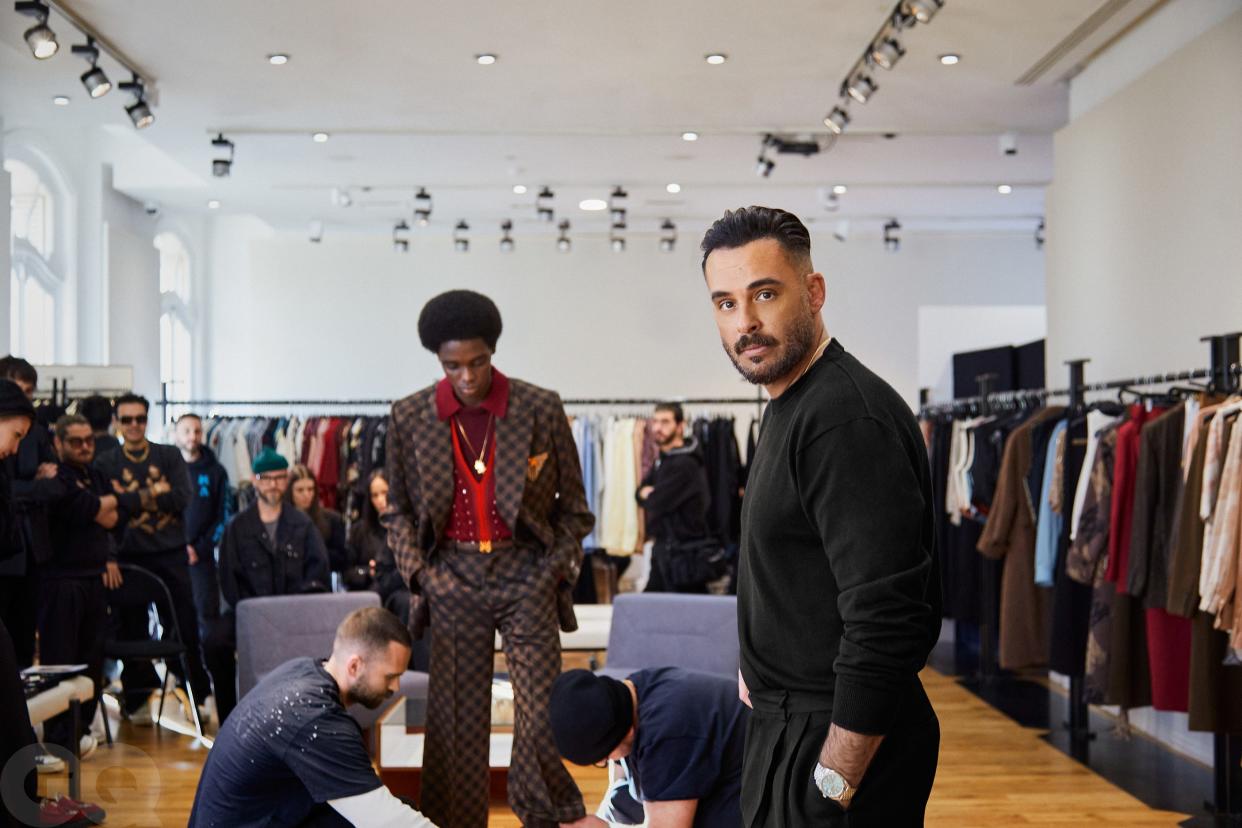
- Oops!Something went wrong.Please try again later.
- Oops!Something went wrong.Please try again later.
On the night of the American fashion industry’s biggest awards ceremony, Mike Amiri is getting ready in a suite at the Crosby Hotel. There are flashbulbs firing and a small army of publicists hovering, but Amiri is quiet and locked in. He bounces a little in his large white sneakers, adjusts the sequin-encrusted wool boutonnière affixed to the lapel of his tuxedo jacket. He looks as if he’s mentally running through an acceptance speech, which he might have to give in a few hour’s time at the 2023 CFDA Fashion Awards, where he is nominated for Menswear Designer of the Year.
I ask if he prepared any remarks beforehand. “No, I never do,” he says. Instead, he’s well-practiced in something you see often on the Oscars split-screen. He flashes a very bright smile. “I have my un-disappointed clap down pretty good.”

Tonight marks Amiri’s fifth nomination; so far the 47-year-old designer is empty-handed. Past winners in the menswear category include luminaries like Marc Jacobs, Tom Ford, and Thom Browne, and the prize—voted on by editors, buyers, Council of Fashion Designers of America members, and other industry bigwigs—comes with something more important to many designers than money. To win a CFDA is to be legitimized by the establishment. The awards are meant to summarize a year of fashion excellence, which means they track the pulse of voter’s purely subjective tastes. It’s a popularity contest, and the trophy is a nod from the in-crowd that you can finally join them at the table.
Amiri is plenty popular in the marketplace. In 2023, his business surpassed $300 million in annual sales, making it a rare American menswear label to achieve legitimate commercial scale in recent years, with over a dozen stores around the world, a couple hundred employees at an office in downtown LA, and a coveted spot on the Paris Fashion Week calendar. But the brand is polarizing, and many fashion insiders look down at arrivistes in their midst, especially ones not exactly seen as paragons of sophisticated taste. The Olsens were warmly welcomed when they began showing The Row in Paris. But they make opulent quiet luxury. Amiri was built on ripped skinny jeans and other uber-trendy rock ’n’ roll touchstones.
A sure factor in why Amiri has been passed over by the old guard is also a key source of the brand’s strength: its gravity-defying levels of pure clout. Amiri is ubiquitous in the NFL and NBA tunnels and a staple in the wardrobes of young Hollywood and hip-hop stars, a leading outfitter of a spendy demographic heavily courted by (if not always warmly embraced) by much older fashion houses. Amiri does plenty of traditional advertising, but the brand has something more important than all the billboards money can buy, which is a network of famous fans who have made the name synonymous with flexing.
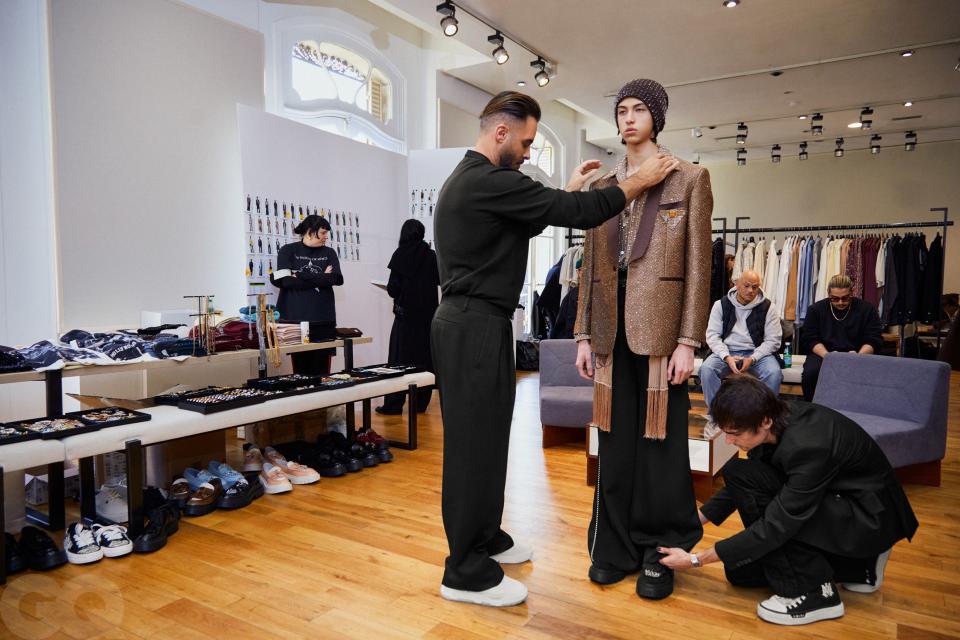
Even Amiri has been surprised by how strongly his brand has been embraced as a status symbol by the hip-hop world in particular. (To quote Polo G: “My pants Amiri, yes, I'm winnin’, clearly.”) “Music has been a big part of a driving force behind Amiri, and it was without my intention,” says Amiri. “It just got adopted at some point, and it kind of exposed a lot of people to learn more about what I do. And it also put me in a position where I was like, all right, you have to really drive this forward—there's a lot of eyes on you.”
“Amiri has really cultivated its own version of luxury,” says Jian DeLeon, the fashion director of Nordstrom Men’s. “It's such a uniquely American spirit, and I think that's why everybody continues to root for him. He grows and progresses the same way his customers do.”
But Amiri is deeply, almost frustratingly humble, and is managing his own expectations for the night. He is, he tells me, just happy to be nominated. “It’s just great to be in the conversation. It means that you did something right that year, to have that sort of visibility.”
Come on, I say. You really want to win, right?
“Yeah, umm…” Amiri trails off, pauses. “That uphill climb or chip on the shoulder is really what's kind of driven me to do more,” he says. “If this wasn't enough, how about this? Or how about this?” He laughs. “If it’s not this time or the next time, it'll be a lifetime achievement award one day, or something like that.”
In other words, what Amiri has besides a CFDA Award and the attendant industry respect is, basically, everything. Meanwhile, he’s been fighting to make his acceptance an inevitability. Zoom out and in Amiri you can start to see the rise of a new international luxury powerhouse—something that happens in American menswear once or twice in a generation.
I pile into a black Escalade with Mike, his wife, Shirin, and the actor and musician Lakeith Stanfield, who is Amiri’s other date to the CFDA Awards. Stanfield, riding shotgun, says he discovered Amiri through hip-hop: “A lot of artists that I was listening to were wearing it.”
Amiri’s relationship to celebrity, and his understanding of how to harness it, reminds me a bit of his friend Virgil Abloh’s. With Abloh, a fellow American fashion unicorn, there was little distinction between client and ambassador and homie. At Amiri, I get the sense that he tends to his community with the same care that he gives his collections. And it seems like the rappers and hoopers who wear his gear and attend his shows also genuinely love hanging out with Amiri, who is warm and thoughtful, prone to pauses in conversation as he searches for just the right thing to say. He is also an ideal representative of his own idea of LA luxury—Amiri looks deeply relaxed at all times, with a wrinkle-free tan and a slicked-back undercut that somehow always looks perfect.
But Amiri also represents a hustle culture success story, someone who came from outside the system and reached the top through a combination of grit and grindset. He leans into it, posting his own motivational quotes on Instagram. One goes like this: “Bet everything on yourself. The only gamble is for those who bet against you.” Most fashion designers use social media—if they use it at all—to project a sort of sophisticated mystery. Amiri uses it like your high school basketball coach.

Amiri’s underdog mindset formed early on. An LA native, he attended UCLA where he majored in history. In the car, he claims he was a listless student before his wife corrects the record: he in fact graduated summa cum laude. “Oh yeah. Alright, I did pretty good,” he says. “I was good at memorizing.” Shirin also attended UCLA, but they didn’t meet until graduating when they were taking care of mutual friends after a night of partying in Las Vegas. Soon after, Amiri went to Loyola Law School, which is when he did become a terrible student. “I cannot believe they let me graduate,” he says. At that point, he had already decided he was going to be a fashion designer. His program was located in LA’s fashion district, and Amiri spent his days knocking on factory doors, trying to figure out how to make clothes. “Shirin thought she nabbed a lawyer,” he says, “and she ended up with a struggling designer.”
Which is probably a good time to mention Mike Amiri’s brief sojourn into the world of K-pop. One thing I wanted Amiri to help me understand was where his overwhelming belief in his own creative ability came from, how a law student decided to make jeans one day and ended up with a $300 million fashion empire. One clue is that, after graduating, one of his best friends became a K-pop artist. (Amiri is vague about the details—it’s just about the only thing we discuss that he seems eager to move on from.) As for how he got involved in his buddy’s rocket-ship career, Amiri is plain: “I was a creative,” he says. Creative people make things, and so he started flying between LA and Seoul, writing and producing songs for K-pop artists as the scene began going global. “Somewhere I'm considered one of the earlier founders of certain music styles over there,” he says. “It was a weird thing I fell into for four or five years.”
As a songwriter, he says, “I could hear something that wasn’t there.” With fashion, he adds, “I could see something that wasn’t there, or the way clothes should be.” The experience also taught him, he says, the value of audacity and what it was like to be “close to the stage.” Which, critically, helped him understand what musicians wanted to wear, and his early men’s clients were rockers like Steven Tyler and Axl Rose. In 2014, Amiri officially launched at Hollywood luxury boutique Maxfield’s at the peak of skinny jeans mania.
“I knew that he was going to be something,” says Shirin. “He just always had that thing that some people have. I always believed in him.”
Like many other self-made artists who have fallen into Amiri’s thrall, when Stanfield met the designer, he recognized him as a fellow traveler, an inspirational outsider who happened to also make dope clothes. “I really like his approach,” he continues. “It's people like Mike who are showing there are different routes to get to things, and saying that we can all get there, but we can do it our way.”
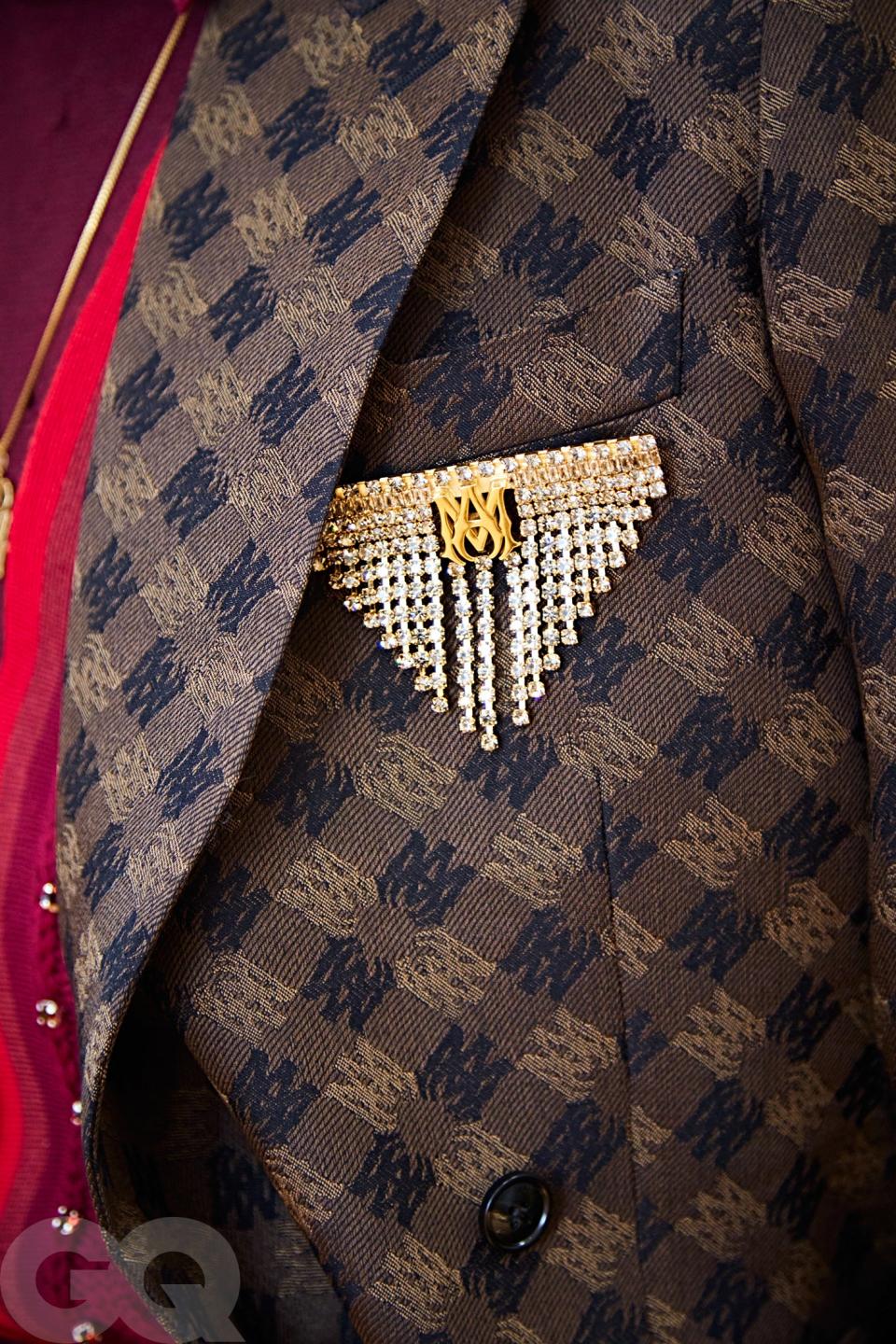
Of course, none of it would work if Amiri didn’t sell his customer what they wanted. Back in 2014, that thing was leg-clinging denim. His whole line was extremely on-trend for the moment, downstream of Hedi Slimane’s grungy Viper Room-rocker style. He was mimicking a well-established formula, but Amiri mimicked it with a certain meticulousness. Early on, he got a guy out in the desert to shoot sweaters and jeans with a shotgun to achieve an aggressive moth-eaten effect. Soon, his skinny moto jeans—thrashed and patched with bandanas—caught fire and put his name on the map. (In 2018 alone, he was name-dropped 56 times in rap songs.) “The rock ’n’ roll aesthetic was coming out of the LA that I understood,” says Amiri.
He had something that doesn’t come along very often in fashion: a legitimate organic commercial smash. And then, in 2021, he changed his brand’s entire aesthetic. All of a sudden, his collections didn’t feature so much as an exposed kneecap. Gone were the skinny jeans, replaced with huge tailored trousers cut in fluid wool fabrics with wide bootcuts. In place of his bomber jackets were double-breasted leather blazers. He embraced bouclé tweed, last seen in your grandmother’s closet. It was still sleazy, but in a more sophisticated way, and represented a totally different vision of modern luxury for a rising generation of fashion obsessive. All of a sudden, Amiri wasn't selling the life of a hedonistic Axl Rose wannabe. He was selling a life of sophisticated leisure. “My rockstar was not that rockstar anymore,” says Amiri of dropping the skinny jeans. “My rockstar was coming out of an NBA tunnel. It’s been an evolution for me of identifying that guy.”
There was something incongruous about a designer synonymous with hype and an aughts-era silhouette leading his customer to pleated-pants nirvana. But he had enough clout to get his fans to follow him, and Amiri now looks extremely trendy in an entirely new way, a reflection of our current elevated-casual menswear moment. As Vogue Runway put it in 2022, “Does Amiri look like everything or does everything look like Amiri?”
“Wayne Gretzky has this thing that I always say in the office,” Amiri says. “You don't go to the puck, you go to where the puck is going.”

Part of Amiri’s winning formula, though, is that he keeps the other rockstars around, too. Later, he tells me about a recent visit to his flagship on Rodeo Drive. A dad and his two teenage sons walked in. The dad told Amiri he learned about the brand through Metallica guitarist Kirk Hammett, and the sons asked him what it was like to meet Lil Durk, who walked in an Amiri runway show in 2022. “That made me so happy that generationally, it, like, works,” Amiri says. “It shows how wide the audience can be.”
Amiri still sells a ton of jeans—“enough to build 15 retail stores on the luxury streets around the world,” as he puts it when I ask him for numbers—but he says denim is no longer the dominant category in the business as he grows footwear, knitwear, and tailoring.
Later that night, Amiri left the CFDA Awards empty-handed for the fifth time.
Two days before his Fall-Winter 2024 runway show in Paris, I find Amiri in a palatial studio off the Champs-Élysées. In many ways, the vibe is indistinguishable from the studios owned by the major French houses. There are several models trying on looks for final fittings, attended to by styling and casting assistants. Rails heaving with clothes stretch all around. There are a lot of French people. But at the center of it all is the very American designer, orchestrating the chaos in the comfort of an Amiri sweatsuit.
In Paris, the beating heart of international luxury, Amiri isn’t sweating the CFDA. He feels like he’s on the cusp of something much bigger: a house of his own.
It’s a word he’s used to describe Amiri for a long time, but now it’s feeling stickier. “Five years ago when I talked about the brand as a house, people would always give me a weird look,” he says. “And now the same people are like, Wow, you’re really building a house.”
Of course, by the standards of the historic brands headquartered not far from here, Amiri is still small potatoes. Amiri might have taken over the retail location of an Hermès store in Las Vegas in 2021, a fact he was immensely proud of, but $300 million doesn’t look like much compared to Hermès’s $12+ billion in annual sales.
Which makes Amiri even more conscious that his shows have to be perfect. Global luxury fashion houses don’t just do shows, they hold something that’s more like an immersive theatrical production, one that begins as soon as the invite lands on your hotel bed. Every last detail of the experience is connected to the theme of the collection and to the sensibilities of the brand. Last year, Amiri recalls, he received seven different bags of pebbles at his office in LA so he could choose the perfect ones to spread on the runway in June. “All of these little details you don't think are important—they're all really, really important,” he says.
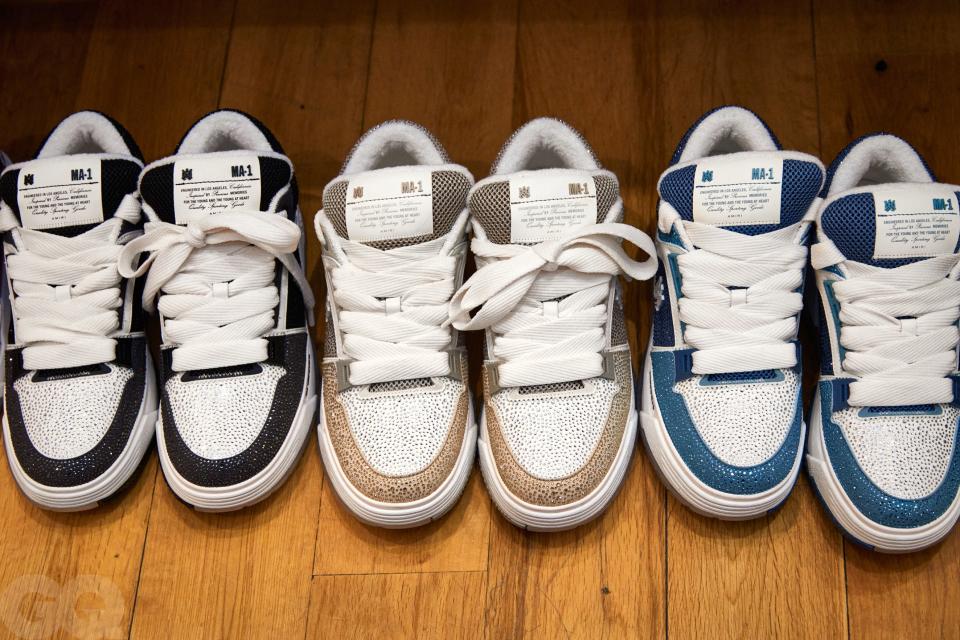
His first show in Paris, in 2018, was a rogue production. Back then, he couldn’t get an official spot on the Paris Fashion Week calendar from the governing Fédération de la Haute Couture, so he decided to show up in Paris with a collection and figure it out himself, off-schedule. He flew in the surfy band Goth Babe from LA and sent around an invite. “I remember I wanted it to feel like MTV Unplugged,” he said of the show, so he laid down rugs and lit candles in the room. He didn’t understand any of the things he does now: “The nuances of styling, of how clothes fit, cohesiveness, color story, all these little things.” But the first show had a decent turnout, and so he did it again six months later. By that point, the hype was real. “It threw off the calendar,” Amiri fondly recalls. So many people attended that the FHCM had to give him an official slot in 2019. That year, OTB Group, which owns the likes of Diesel, Marni, and Maison Margiela, took a minority stake in Amiri.
This season will be Amiri’s biggest show ever. He’s expanding the guest list to around 800 from half that from the previous show, owing to what Amiri says is a surge of interest from talent and global press. Gunna, Quavo, Westside Gunn, and Yasiin Bey are set to attend. But as he’s solidified his place in Paris, Amiri’s work has come to feel divorced from its original LA identity. His June show was slick and relaxed and very French-looking, an LA designer’s idea of French style. If his early designs were downstream of Hedi Slimane, now it felt more indebted to Kim Jones, the king of cosmopolitan luxury menswear.
Now, Amiri appears closer to a breakthrough. He is skating to where he thinks the puck is going. He is going back to Hollywood. “To me, this show is our first show,” he says. “It's our first show because we're now discovering the full potential of what Amiri can be.”
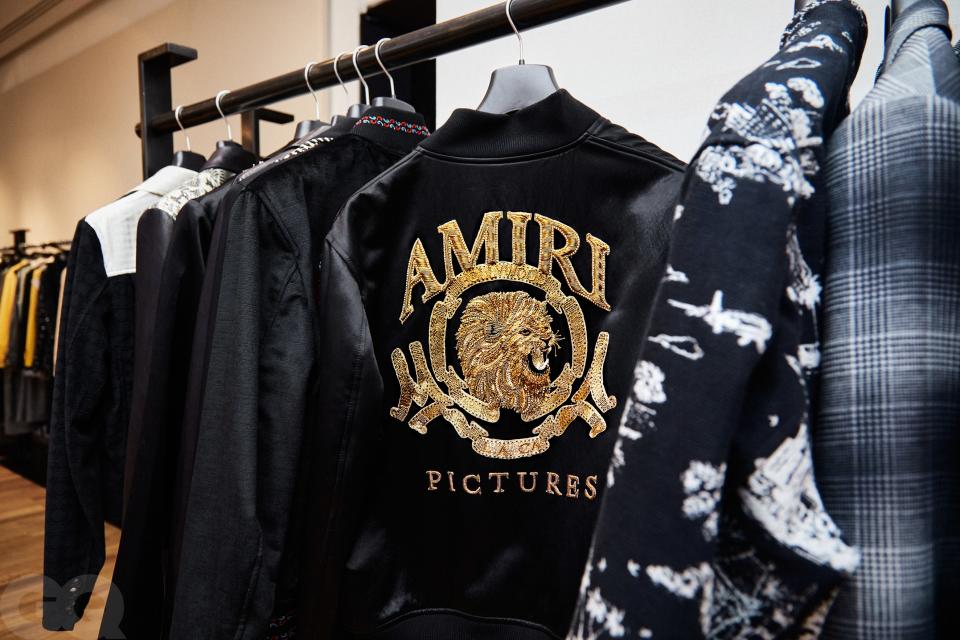
As he reviews the final looks, he explains that his muse for the season was a young Leonardo DiCaprio, a burgeoning movie star who still had a grungy edge: “That moment of his career when he was mixing both suiting and skate style, where you couldn’t tell what was thrifted and what was bought.” The show will include sharp shawl collar dinner jackets made for red carpet rebels, and trousers cut like baggy skate pants, which he identifies as a strong emerging code for Amiri. “Houses,” he says, “have codes.” Houndstooth coats and bowling shirts call back to the ’50s, another recurring reference point for the designer, who admires the era’s optimism—“the best parts of Americana,” he says. There is an abundance of sequins and crystals and flashy jacquards, showcasing a level of handiwork Amiri is now capable of.
And though he’s bringing leopard print back, skinny jeans are staying on the sidelines. “I think it was something I avoided in the past few years, because doing California and the rock thing was too literal,” Amiri says. “And I think now that we've really been able to refine our DNA, there's a way to express a bit of that LA feeling in our own language that feels newer and fresher, with proportions and details and real thoughtfulness. So I've become really comfortable with that.”

Amiri is more determined than ever to break down the doors of the establishment. To make his work so undeniable that the old guard has no choice but to put respect on his name. As his name has grown, he’s looked to one of the great American designers who made a legitimate global impact on fashion: Tom Ford, a fellow renegade world-builder who proved the naysayers wrong after landing at Gucci in the ’90s, and then turned himself into a titan of new luxury. They sat down together in LA about a year ago. Amiri tells me he had endless questions for Ford, but he keeps coming back to one as he grinds his way forward. “I asked him: ‘How long will it be so difficult?’” Amiri says. “He said, ‘It’s always going to be difficult because you care. And it’s good because you care, and you’re going to suffer before you care.’” He pauses and smiles at the memory. “How cool is that?”
Originally Appeared on GQ
More Great Style Stories From GQ
How Jeremy Allen White Prepped for His Calvin Klein Underwear Campaign
Daniel Day-Lewis Is the Final Boss of Workwear
Why True Watch Heads Never Set the Time on Their Watches
After an 11-Year Wait, Air Jordan Is Bringing Back a Highly Coveted Sneaker
John Mayer Wore an Epic Royal Oak to Ring in 2024 at a Tokyo Cat Bar
Not a subscriber? Join GQ to receive full access to GQ.com.

